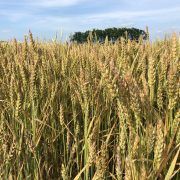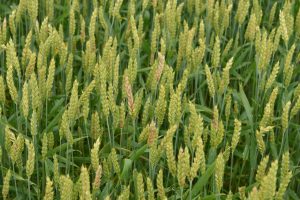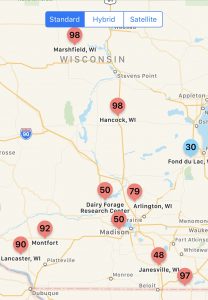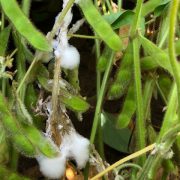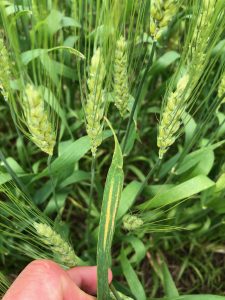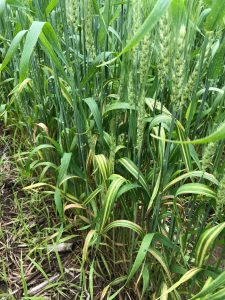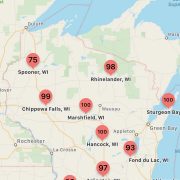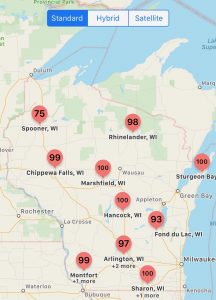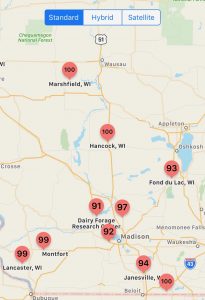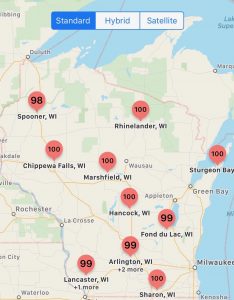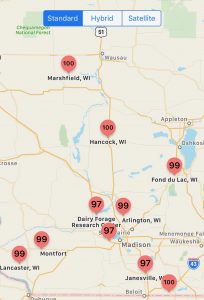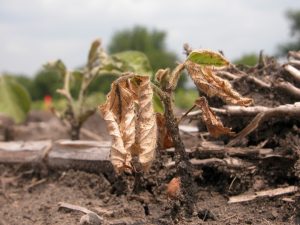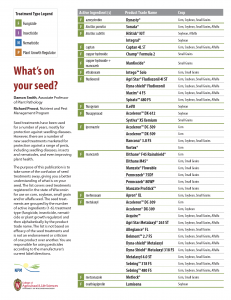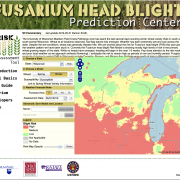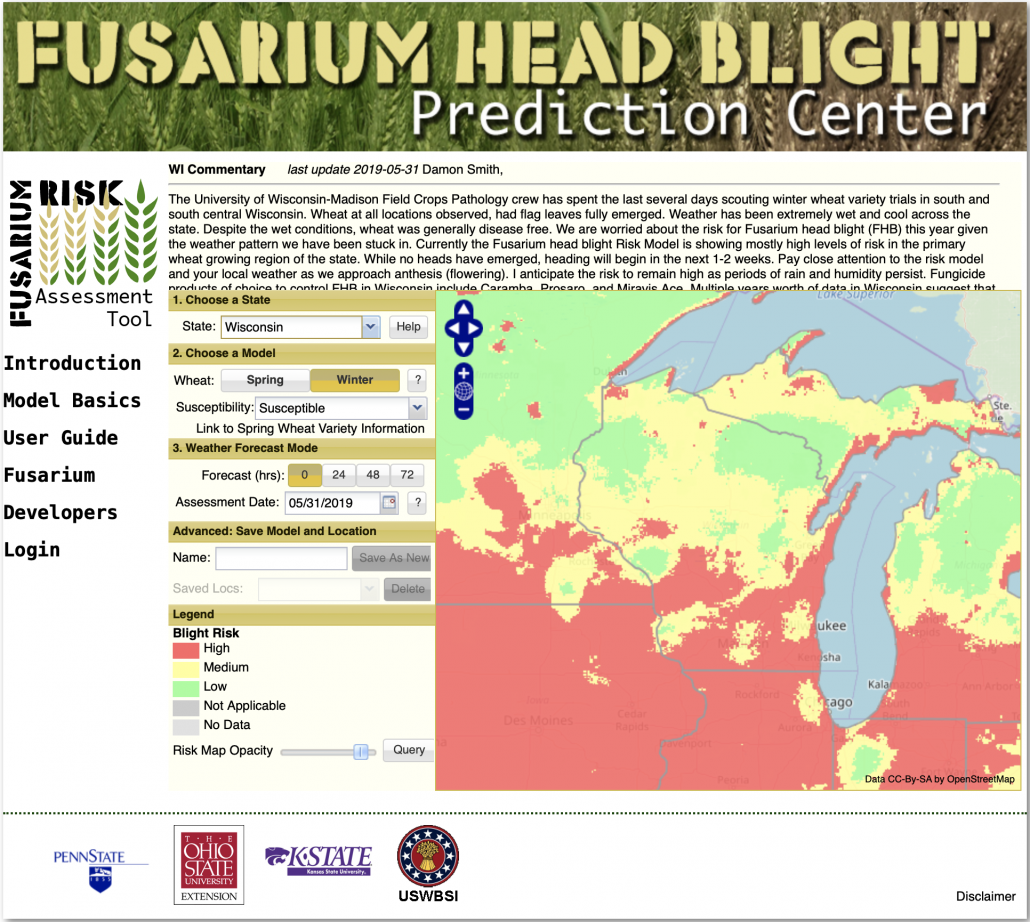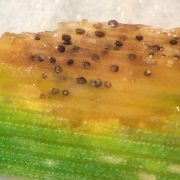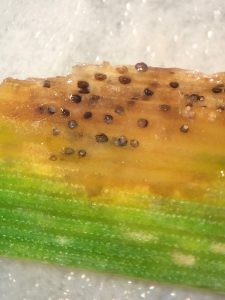Damon Smith, Extension Field Crops Pathologist, Department of Plant Pathology, University of Wisconsin-Madison
Shawn Conley, Extension Soybean and Small Grains Agronomist, Department of Agronomy, University of Wisconsin-Madison
Roger Schmidt, Nutrient and Pest Management Program, University of Wisconsin-Madison
Paul Mitchell, Extension Economist, Agricultural and Applied Economics, University of Wisconsin-Madison

Figure 1. Apothecia, small mushroom-like structures of the white mold fungus that give rise to spores, which infect soybean flowers
In Wisconsin, the first week of July brings us a heightened awareness of white mold in soybeans, and its management. In 2017 we had one of the most epic white mold epidemics on record. While 2018 wasn’t quite as significant of a white mold-year, we did have significant pockets of the disease in Wisconsin. With the late planting and cool, wet weather we have had in 2019, are we in for a bad white mold year? Yes, I think it could be possible.
Weather in 2017 was incredibly cool for the majority of the time. This had two effects which were responsible for the extreme white mold epidemic in 2017. First, soybeans moved extremely slow through each growth stage. This meant that the flowering window went on for about twice as long as normal for many of the varieties of soybeans we grow here in Wisconsin. This extended flowering period resulted in an extended period of time that soybeans were susceptible to infection. Remember that the white mold fungus infects soybeans through open and senescing flower, by spores that are born from small mushroom-like structures called apothecia (Fig. 1). This extended bloom period meant that the window of opportunity for the fungus was also extended. Couple this with the fact that those same cool conditions were also optimal for the fungus to infect and grow. It was a double whammy in 2017.
Weather in 2018 was warmer, before and during bloom. This pushed soybean plants through growth stages quickly, leaving them less susceptible to infection by the white mold fungus impaired to 2017. The warmer weather was also less conducive for the fungus. Thus, we saw only pockets of white mold in 2018.
This brings us to 2019. Now we might be rotated back into fields that had high white mold pressure in 2017. This means there is a lot of inoculum potential in fields where soybeans are planted this season. The wet and cool spring has delayed planting, pushing soybean growth stages back. Cooler temps will also slow soybean development. This means that soybeans may be at very susceptible growth stages, longer and later in the season. This could set us up for significant white mold, but we need to pay attention to what the weather is doing as soybeans move through the flowering growth stages.
Predicting White Mold

Figure 2. Sporecaster predictions for selected non-irrigated locations in Wisconsin for July 1, 2019.
The flowering growth stages are a critical time to manage white mold in-season. You can view a fact sheet and video on the subject. As you probably know, timing in-season fungicide sprays at the correct time during the soybean bloom period can be extremely difficult. To help solve this decision-making issue, models were developed at the University of Wisconsin-Madison in conjunction with Michigan State University and Iowa State University to identify at-risk regions which have been experiencing weather favorable for the development of white mold apothecia. These models predict when apothecia will be present in the field using combinations of 30-day averages of maximum temperature, relative humidity, and wind speed. Using virtually available weather data, predictions can be made in most soybean growing regions. To facilitate precise predictions and make the model user-friendly, we have launched the Sporecaster smartphone application for Android and iPhone.
The purpose of the smartphone app is to assist farmers in making early season management decisions for white mold in soybean. The best time to spray fungicides for white mold is during flowering (R1 and R3 growth stages) when apothecia are present on the soil surface.
Sporecaster uses university research to turn a few simple taps on a smartphone screen into an instant forecast of the risk of apothecia being present in a soybean field, which helps growers predict the best timing for white mold treatment during the flowering period.
University research has indicated that the appearance of apothecia can be predicted using weather data and a threshold of percent soybean canopy row closure in a field. Based on these predictions and crop phenology, site-specific risk values are generated for three scenarios (non-irrigated soybeans, soybeans planted on 15″ row-spacing and irrigated, or soybeans planted on 30″ row-spacing and irrigated). Though not specifically tested we would expect row-spacings of 22 inches or less to have a similar probability response to fungicide as the 15 inch row-spacing.

Figure 3. Sporecaster predictions for selected irrigated locations with soybeans planted to 30″ row-spacing in Wisconsin for July 1, 2019.
The Sclerotinia apothecial models that underlie the Sporecaster prediction tool have undergone significant validation in both small test plots and in commercial production fields. In 2017, efficacy trials were conducted at agricultural research stations in Iowa, Michigan, and Wisconsin to identify fungicide application programs and thresholds for model implementation. Additionally, apothecial scouting and disease monitoring were conducted in a total of 60 commercial farmer fields in Michigan, Nebraska, and Wisconsin between 2016 and 2017 to evaluate model accuracy across the growing region. Across all irrigated and non-irrigated locations predictions during the soybean flowering period (R1 to early R4 growth stages) were found to explain end-of-season disease observations with an accuracy of 81.8% using the established probability thresholds now programmed in the app.
Not only can users run predictions of risk during the soybean bloom period for any field, you can also set up visual maps to look at multiple sites simultaneously. An example for the state of Wisconsin can be found in figure 2, which represents risk for July 1, 2019 for non-irrigated soybeans. Figure 3 illustrates statewide risk for irrigated sites with soybeans planted to 30” row-spacing for July 1, 2019. Currently, if soybeans are flowering, risk is moderate in the southern third of Wisconsin for non-irrigated soybeans. Risk is high in the central and northern tiers of the state. For irrigated soybeans planted to 30″ row-spacing, risk is high in the southern and central portions of the state. Areas in the far north have reasonably low risk. Fields planted to narrower row-spacing, under irrigation would be at higher risk than that represented by figure 3. Check back to this blog regularly as I will post maps like these with interpretation of risk for Wisconsin as we move through the season.
What to Spray for White Mold?
If you have decided to spray soybeans for white mold, what are the best products to use? Over the last several years we have run numerous fungicide efficacy trials in Wisconsin and in conjunction with researchers in other states. In Wisconsin, we have observed that Endura applied at 8 oz at the R1 growth stage performs well. We have also observed that the fungicide Aproach applied at 9 fl oz at R1 and again at R3 also performs comparably to the Endura treatment. Other fungicide options also include Omega and Proline. You can view results of past fungicide evaluations for Wisconsin by CLICKING HERE.If you would like to run tailored estimations of return on investment for various fungicide programs, you can use another smartphone application called Sporebuster.
What is Sporebuster?
When a fungicide application is needed to control white mold in soybeans, Sporebuster can help determine a profitable program. You enter your expected soybean price, expected yield, and treatment cost. Sporebuster instantly compares ten different treatment plans at once to determine average net gain and breakeven probability of each. You can mark, save and share by email, the best plans for your farming operation.
The purpose of Sporebuster is to assist soybean farmers in making a fungicide program decision that is profitable for their operation. Sporebuster is meant to complement Sporecaster. Once Sporecaster recommends a fungicide application, Sporebuster can be used to determine a profitable program.
Information that drives Sporebuster is based on research from 2009-2016 from across the upper Midwestern US. Statistical models were developed based on these data that included white mold pressure and yield response from fungicide for 10 common fungicide programs.
Helpful Smartphone Application Links
Sporecaster
- Click here to download the Android version of Sporecaster.
- Click here to download the iPhone version of Sporecaster.
- Here is a helpful video if you would like some tips on how to use Sporecaster. If you would like some advice on how to interpret the output, we have created an additional short video on this subject.
Sporebuster
- Click here to download the Android version of Sporebuster.
- Click here to download the iPhone version of Sporebuster.
- Here is a video on how to use Sporebuster and interpret the output.
Other Resources
- To watch an in-depth video on white mold management, CLICK HERE.
- To find more information and download a fact sheet on white mold from the Crop Protection Network, CLICK HERE.
Scientific References
- Willbur, J.F., Fall, M.L., Blackwell, T., Bloomingdale, C.A., Byrne, A.M., Chapman, S.A., Holtz, D., Isard, S.A., Magarey, R.D., McCaghey, M., Mueller, B.D., Russo, J.M., Schlegel, J., Young, M., Chilvers, M.I., Mueller, D.S., and Smith, D.L. Weather-based models for assessing the risk of Sclerotinia sclerotiorum apothecial presence in soybean (Glycine max) fields. Plant Disease. https://doi.org/10.1094/PDIS-04-17-0504-RE
- Willbur, J.F.,Fall, M.L., Byrne, A.M., Chapman, S.A., McCaghey, M.M., Mueller, B.D., Schmidt, R., Chilvers, M.I., Mueller, D.S., Kabbage, M., Giesler, L.J., Conley, S.P., and Smith, D.L. Validating Sclerotinia sclerotiorumapothecial models to predict Sclerotinia stem rot in soybean (Glycine max) fields. Plant Disease. https://doi.org/10.1094/PDIS-02-18-0245-RE.
- Fall, M., Willbur, J., Smith, D.L., Byrne, A., and Chilvers, M. 2018. Spatiotemporal distribution pattern of Sclerotinia sclerotiorum apothecia is modulated by canopy closure and soil temperature in an irrigated soybean field. Phytopathology. https://doi.org/10.1094/PDIS-11-17-1821-RE.
- Willbur, J.F., Mitchell, P.D., Fall, M.L., Byrne, A.M., Chapman, S.A., Floyd, C.M., Bradley, C.A., Ames, K.A., Chilvers, M.I., Kleczewski, N.M., Malvick, D.K., Mueller, B.D., Mueller, D.S., Kabbage, M., Conley, S.P., and Smith, D.L. 2019. Meta-analytic and economic approaches for evaluation of pesticide impact on Sclerotinia stem rot control and soybean yield in the North Central U.S. Phytopathology. https://doi.org/10.1094/PHYTO-08-18-0289-R.

